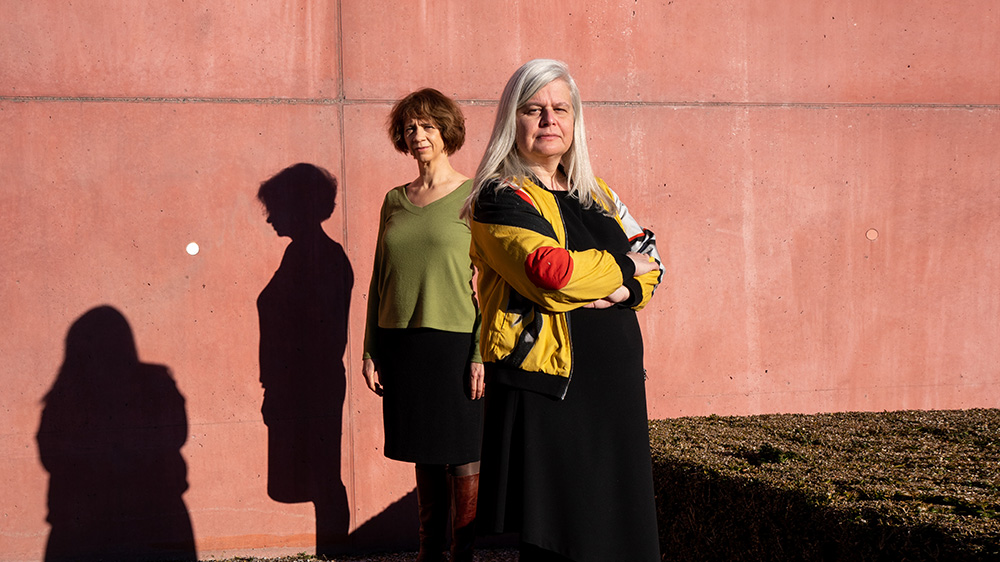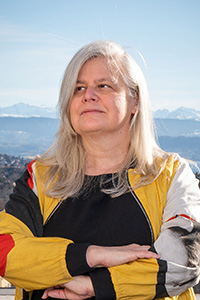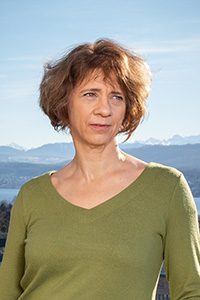“We are not judges”

Monika Dommann, Marietta Meier, you have been commissioned to investigate cases of abuse in the Catholic Church since 1950. How did this project come about?
Marietta Meier: The church approached us, and we negotiated for a long time. Among other things, this involved gaining access to the (secret) archives and being assured of freedom of research and publication.
This is commissioned research. Why did you accept the assignment?
Meier: Research into abuse in the Catholic Church and the structures that made it possible – and difficult to uncover – for so long is a desideratum of historiography, both in Switzerland and internationally. Although there have already been studies in other countries, these were not primarily conducted by historians, but by theologians, psychologists or sociologists.
What interests you about this topic?
Monika Dommann: We want to understand why massive abuse of power and sexualized assaults took place in the Catholic Church and why the church did not face up to such accusations for so long.
Meier: We are not only investigating the individual cases of abuse, but also the power structures within the church, which are also connected to state structures. Often this isn’t obvious at first glance. I am also interested in ideas about sexuality within the Catholic Church. How the utterable and the unutterable are shaped by religion, how sexuality and the body are talked about.
Dommann: The abuse cases could also be investigated by lawyers. They would proceed in a similar way to us: sifting through files, talking to people, looking for irregularities in what they find or don’t find in the archives.
What distinguishes the historical view from the legal?
Dommann: We are not primarily interested in the question of right or wrong, but in social constellations, how attitudes and values change over time. But we’re also interested in the persistence of structures and mentalities.
The Bishops’ Conference set up a commission as long ago as 2002 to deal with sexual assaults in the ecclesiastical environment. The secretary at the time was the current Bishop of Chur, Joseph Bonnemain, who is considered a driving force in dealing with the abuse cases. Why did it take so long for the Catholic Church in Switzerland to bring itself to undergo an external reappraisal?
Meier: The first task of these church bodies was prevention. The intention was to prevent further abuses, and bodies were created to which victims of abuse could turn.
Dommann: The appointment of Joseph Bonnemain as Bishop of Chur also changed the balance of power within the Bishops’ Conference. This was probably a tipping moment that helped the movement that advocates scientific research within the Catholic Church to achieve a breakthrough. Furthermore, large-scale studies from Germany and France document hundreds of thousands of cases of abuse. This has increased the pressure to launch a scientific investigation into this topic in Switzerland as well.
How do you intend to shed light on this?
Meier: On the one hand, we have access to the archives of the church, including the secret archives of the dioceses, where the church’s internal penal files are kept. On the other, several people have contacted us who have experienced abuse or know people who have experienced sexualized violence. And we will be working with victims’ organizations to contact those affected. This will allow us to match the statements of these individuals with those recorded in the written sources. It will be interesting to see what is documented and how, and where gaps can be identified. In addition, there are also files in the state archives, for example, of cases that were investigated by the public prosecutor’s office and came before secular courts.
Will you also be talking to offenders?
Dommann: We want to grasp the entire complex structure of the problem, so we will be talking to selected victims as well as to perpetrators – if they are willing to do so. In follow-up projects, the aim will be to systematically expand the spectrum of the most diverse groups of actors and, for example, also to talk to victims’ fathers, mothers and siblings, as well as to document the views of other participants such as parish cooks.

Reappraisal is controversial within the church. What does this mean for your project?
Dommann: After the initial discussions we held with representatives of the Catholic Church more than two years ago, we realized that our project would be part of the Catholic Church’s confrontation with this problem. At the moment, the forces that support reappraisal are stronger. We hope that it will stay that way. It isn’t unusual for historical research to take place against a background of social conflict. Conflicts over access to records occur time and again, especially in corporate or other private archives, but also in public archives. A particularly prominent example was the closure of files in connection with research into Switzerland’s role in South Africa during the apartheid period.
What role does the historical reappraisal of abuse cases play in the church’s confrontation with its own past?
Meier: Our project is part of this confrontation, which takes place on different levels. We are trying to make a scientific contribution towards this. If problems arise in the process, we will address them and make them transparent – within the scientific community, on the one hand, but if necessary also in public. That’s why we cooperate with the Swiss History Society.
Dommann: I find it appealing that at UZH – the university of a traditionally “reformed” canton – we are pursuing a project that deals with Catholicism. In the past, such a project would probably have been located in Fribourg or Lucerne as a matter of course. This opening also reflects today’s understanding of research, which is committed to the plurality of perspectives and is aimed at introducing future historians to such discussions. For example, next spring we will be holding a colloquium on sexuality in the Catholic Church of the 20th century. Ideally, the subject is like a rhizome that begins to grow vigorously.
The question will be how far the reappraisal will go and whether it will not ultimately serve primarily to draw a line under the sorry affair. After the Bergier report, for example, some of the archives that had been temporarily accessible were resealed. Is there also a risk of that happening in this case? What’s your view?

Meier: It's clear to us that after our project, further research must be done on the subject. However, we are aware that access to the archives may again be more difficult or even impossible in the future. But there are other ways of getting to the truth. The people who want to express themselves are also part of the rhizome that Monika mentioned. Oral history will therefore play an important role. What's more, we have contractually agreed to offer all records from the pilot project to the University Archives or transfer them to another non-ecclesiastical archive upon completion. This includes, for instance, copies of sources.
Dommann: Such issues are always a struggle, too. That’s part of it, and we have experience with it as well. I am thinking, for example, of the beginnings of gender studies, which have transformed the study of history, the history of knowledge, penetrated the old domains of natural science or of post-colonial history, which is currently expanding the scope of our research. It takes a certain obsession and tenacity to conduct contemporary historical research.
In the recent past, there have been various projects that have attempted to come to terms with problematic historical contexts, such as the Bergier report on Switzerland’s economic entanglements with the Nazi regime, the forced out-of-home placement of children, Switzerland’s colonial past, or the report on the Bührle Collection at the Kunsthaus Zürich. These research projects were accompanied by at times heated public debates. What role do historians play in such constellations?
Dommann: What is astonishing about the Bergier report is that, although it was the subject of lively discussion among historians, the public was no longer really interested in the subject after the deal with the Swiss banks was struck shortly after the Independent Commission of Experts Switzerland – Second World War (ICE) was set up. The findings of the report were not anchored in the historical consciousness. When I ask younger students about it today, they tell me that they didn’t hear about it in high school. On the other hand, the paths that history takes are mysterious. Last year, for example, the author of the successful SRF television series entitled Frieden (Peace), Petra Volpe, told the audience at an event held by the Department of History that she had been carrying the thick volumes of the ICE with her in a suitcase between New York (where she lives) and Switzerland for years. She then fictionalized this knowledge for Frieden. Thanks to the series, she reignited a broader interest in the history of Switzerland during World War II. This shows how alive the past can be.
History, they say, is constantly being rewritten. This offers opportunities to reassess the past. What can your contribution be in this case?
Dommann: We want to unravel the threads that are important to understanding the current conflicts. Sometimes very long periods of time have to be taken into account. The fact that the Catholic Church is an organization that dates back to the Roman Empire and was able to accumulate a great deal of wealth and power in the process could be important. We will also analyze why certain decisions were made in one direction or another. For example, why priests were transferred to other jobs rather than dismissed. The question of the extent to which developments such as secularization or the so-called sexual revolution played a role must also be asked. And last but not least, it is also important to know if there have been people in the past who have tried to address these issues, within the church, but also from the outside. And how the church reacted.
As the Bergier Commission and the Bührle Collection have shown, it is the clients who ultimately decide what happens to the results. In your case, it will be the Bishops’ Conference. How do you deal with the fact that the sovereignty of interpretation ultimately lies not with you, but with the bishops?
Dommann: Sovereignty of interpretation never lies with historians. Anyone and everyone can express themselves on historical topics. Bishops, religious congregations, parishes and those affected by sexual abuse – they will all make their own sense of our research findings and comment on them.
Meier: We will assess and comment, but not make judgments. We are not judges who must assess guilt in the legal sense, nor will we make recommendations that go beyond our area of expertise, such as the prevention of sexual abuse. It is important for us to be able to publish our report on the website of the Swiss Historical Society without prior influence from the clients. What happens to it afterwards will be part of the public discussion and the debate within the Catholic Church.
This project has put you in the spotlight. How does that feel?
Dommann: We have done media work in other contexts. Once the report has published in the fall of 2023, we will again be doing media work on this project.
This article first appeared in the UZH Magazin, issue no. 2, 2022.